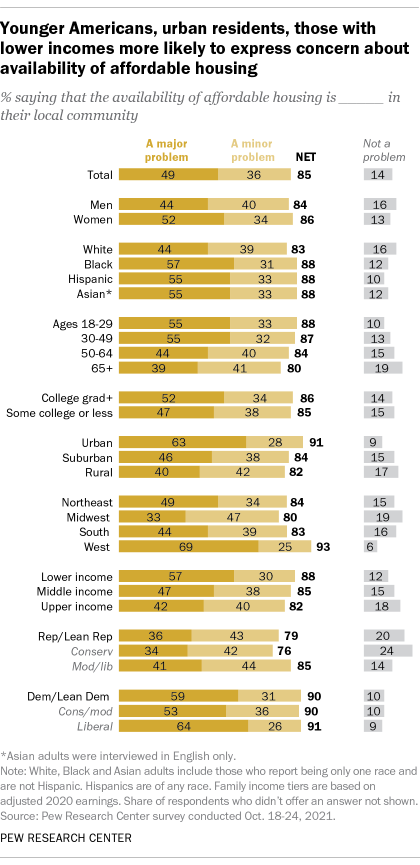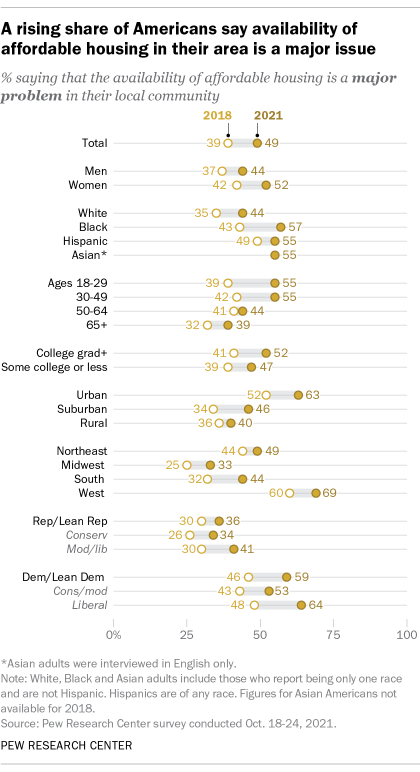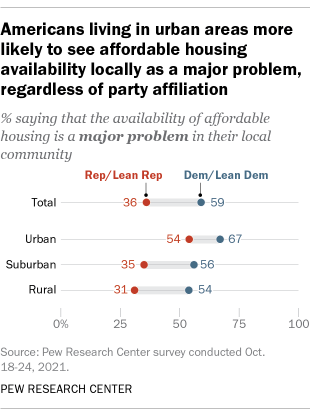
Prospective homebuyers and renters across the United States have seen prices surge and supply plummet during the coronavirus pandemic. Amid these circumstances, about half of Americans (49%) say the availability of affordable housing in their local community is a major problem, up 10 percentage points from early 2018, according to a Pew Research Center survey conducted in October 2021.
This Pew Research Center analysis about the levels of concern among Americans about the affordability of housing draws from a Center survey designed to understand Americans’ views and preferences for where they live.
The survey of 9,676 U.S. adults was conducted from Oct. 18 to 24, 2021. Everyone who took part is a member of Pew Research Center’s American Trends Panel (ATP), an online survey panel that is recruited through national, random sampling of residential addresses. This way nearly all U.S. adults have a chance of selection. The survey is weighted to be representative of the U.S. adult population by gender, race, ethnicity, partisan affiliation, education and other categories. Read more about the ATP’s methodology.
Here are the questions used for this report, along with responses, and its methodology.
References to White, Black and Asian adults include only those who are not Hispanic and identify as only one race. Hispanics are of any race.
“Middle income” is defined here as two-thirds to double the median annual family income for panelists on the American Trends Panel. “Lower income” falls below that range; “upper income” falls above it. Read the methodology for more details.
References to respondents who live in urban, suburban or rural communities are based on respondents’ answer to the following question: “How would you describe the community where you currently live? (1) urban, (2) suburban, (3) rural.”
Another 36% of U.S. adults said in the fall that affordable housing availability is a minor problem in their community, while just 14% said it is not a problem.
Americans’ concerns about the availability of affordable housing have outpaced worries about other local issues. The percentage of adults who say this is a major problem where they live is larger than the shares who say the same about drug addiction (35%), the economic and health impacts of COVID-19 (34% and 26%, respectively) and crime (22%).
Opinions on the question of housing affordability differ by a variety of demographic factors, including income, race and ethnicity, and age. A majority of adults living in lower-income households (57%) say availability of affordable housing is a major issue in their community, larger than the shares of those in middle- (47%) or upper-income households (42%) who say it is a major problem.
Fewer than half of White adults (44%) say that availability of affordable housing is a major problem where they live – lower than the shares of Black (57%), Hispanic and Asian American adults (both 55%) who say the same.
Adults under 50 are more likely than their older counterparts to say affordable housing availability is a major problem locally. More than half of adults ages 18 to 29 and 30 to 49 say this (55% in both age groups), compared with smaller shares of those 50 to 64 and those 65 and older (44% and 39%, respectively).
Americans’ perceptions of this issue also vary based on where they live. About six-in-ten U.S. adults living in urban areas (63%) say that the availability of affordable housing in their community is a major problem, compared with 46% of suburban residents and 40% of those living in rural areas.
Regardless of income level, city dwellers generally tend to view affordable housing availability as a bigger issue than those living in the suburbs or rural areas. Two-thirds of urban adults with lower household incomes (66%) say affordable housing in their area is a major problem, compared with 56% of suburban dwellers with lower incomes and 52% of those with lower incomes living in rural areas. Among upper-income adults, 58% of those living in urban areas say housing affordability is a major problem, compared with 43% of upper-income Americans living in suburban places and 25% of upper-income rural residents.
There are also regional differences. Around seven-in-ten Americans living in the West (69%) say affordable housing availability is a major problem locally. This compares with 49% of Northeasterners, 44% of Americans in the South and 33% of those living in the Midwest.
Since 2018, there have been increases across demographic groups in the shares who say that the availability of affordable housing in their community is a major problem. For example, 55% of adults under 30 now say this is a major problem – a 16 percentage point rise from the 39% who said so in 2018. The share of adults ages 30 to 49 who hold this view has also risen from 42% in 2018 to 55% last year.
About six-in-ten Democrats and independents who lean to the Democratic Party (59%) said in 2021 that affordable housing availability is a major problem in their community, compared with 36% of Republicans and GOP-leaning independents.
These partisan differences remain when looking separately at those who live in urban, suburban and rural communities. Among urban residents, two-thirds of Democrats (67%) see the availability of affordable housing locally as a major problem, compared with 54% of Republicans in urban areas. In suburban or rural communities, smaller majorities of Democrats hold this view (56% in the suburbs and 54% in rural places), compared with around a third of Republicans in those areas (35% and 31%, respectively).
Note: Here are the questions used for this report, along with responses, and its methodology.


